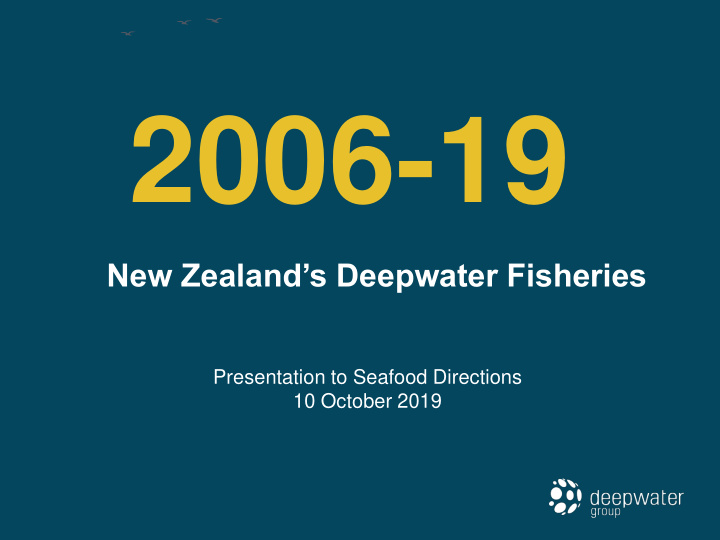



2006-19 New Zealand’s Deepwater Fisheries Presentation to Seafood Directions 10 October 2019
Seafood – the Green Protein “All animal protein production has environmental impacts but seafood has been rated the ‘green protein’” - Professor Ray Hilborn Impacts are significantly less than on land Environmental changes are not permanent Free from: • Pesticides New Zealand Hoki • Herbicides • Hormones • GMOs
Sustainable Deepwater Fisheries DWG unites quota owners, leads sustainable management • Annually harvest 250-300 kt, NZ$650 m, from <1% of NZ EEZ • Annually produce 600,000,000 meals • Underpinned by robust science & co-operative management • Independently verified by MSC - 70% of deep water catch • Seabird and marine mammal interactions reduced to very low levels – no adverse risks to populations • MPAs - 30% of EEZ closed to trawling - sets aside large representative areas of benthic biodiversity – most are pristine
Annual Harvest Catch FOB Value (NZ$) 350,000 700,000,000 300,000 600,000,000 FOB Value (NZ $) 250,000 500,000,000 Catch (mt) 200,000 400,000,000 150,000 300,000,000 100,000 200,000,000 50,000 100,000,000 - - Fishing Year
Increased Efficiencies Trawl catch 95% - 99% retained and utilised: 28% 200% 40% Reduction in Increase in Reduction in the number of tows* observer coverage* number of trawlers* 39,000 in 2005-06 16% in 2005-06 52 in 2005-06 31 in 2017-18 28,000 in 2017-18 48% in 2017-18 *Trawlers >28 m LOA
Certified Sustainable deepwater fisheries certified as ecologically 15 sustainable by Marine Stewardship Council 70% of the deepwater catch 2 hoki fisheries 3 hake fisheries 5 ling fisheries southern blue orange roughy 2 3 whiting fisheries fisheries
Certified Sustainable Marine Stewardship Council provides an independent audit against international ecological and governance standards • Third party audit • Science-based • Transparent • Inclusive • Based on UN guidelines New Zealand Hake
Ecosystem approach Embedded in Fisheries Act, guided by Fisheries Plan, audited by MSC • By-catch and protected species reported + at-sea observers • Fisheries Plan, Annual Operational Plan, Annual Review Report • Fisheries Plan integrated with others (NPOA-seabirds, NPOA- sharks, TMP-sealions) • Risk assessments – no adverse effects on populations • >30% of EEZ closed, trawl footprint monitored, hoki nursery and spawning areas managed
Environmental Effects Since 2006, reduced interactions with protected species: Bird captures Sea lion captures Fur seal captures Dolphin captures 63% 81% 99% 82% Estimated captures Estimated captures Estimated captures Estimated captures 1,985 to 744 50 to 9 1,041 to 200 85 to 0 Declining Albatross by 74% Now close to zero Now close to zero Captures estimated from observer records – many are released alive
Seabirds 10
Seabirds • New Zealand - seabird capital of the world, >80 species breeding • We probably know more, do more, expect more and need to do more than any other nation – that’s the deal here • Significant actions, interventions and processes -13 years for trawl, longer for longline • Progress made - benchmarks well with international results • We still have challenges with trawl net captures of birds 11
Seabirds • We have done a lot and improved a lot • We have not yet done enough • We still have issues with trawl net captures of birds • The base improvements still needed are known and generally tools available • What is “enough” is constantly changing and is always “more and harder • For an increasing “some”, it will never be enough
Seabirds
Sea Lions
Sea Lions 16
Common dolphins
Common dolphins
Environmental Effects Protected Areas 1% of the EEZ is trawled annually of the EEZ has ever 8% been trawled of the EEZ is 30% closed to trawling
Science-based Management Best international scientists engaged Australia, New Zealand, South Africa, Canada, USA, United Kingdom • Stock assessments • Biomass surveys • Ageing studies • New technologies • Environmental studies CSIRO AOS
Summary New Zealand’s deepwater fisheries • Produce sustainable seafood – 600,000,000 meals every year • Ecologically sustainable, science-based management, closely monitored, independently audited • Main fisheries independently assessed as being amongst top 4% of the best managed fisheries in the world • We’ve done a lot and improved a lot – BUT still work in progress • Collaboration between quota owners, MPI, DOC and science service providers (CSIRO in particular) has proven essential
Recommend
More recommend